Clean Air
The Clean Air Act Amendments of 1990 are believed to be essential towards addressing various issues such as pollution and acidic rains.
These amendments have presented new gains such as reduction of toxic compounds in the natural environment. As well, acidic rains have been reduced significantly in the United States.
Witten argues that the amendments have been appropriate towards improving visibility and quality of air (23).
Consequently, this move has improved the living conditions of many people while at the same time minimizing the health challenges associated with pollution.
That being the case, the current policies have been encouraging different stakeholders to focus on the best activities that can reduce air pollution. The quantity of “toxic air pollutants decreased by around 69 percent from 1970 to 2014” (Witten 48).
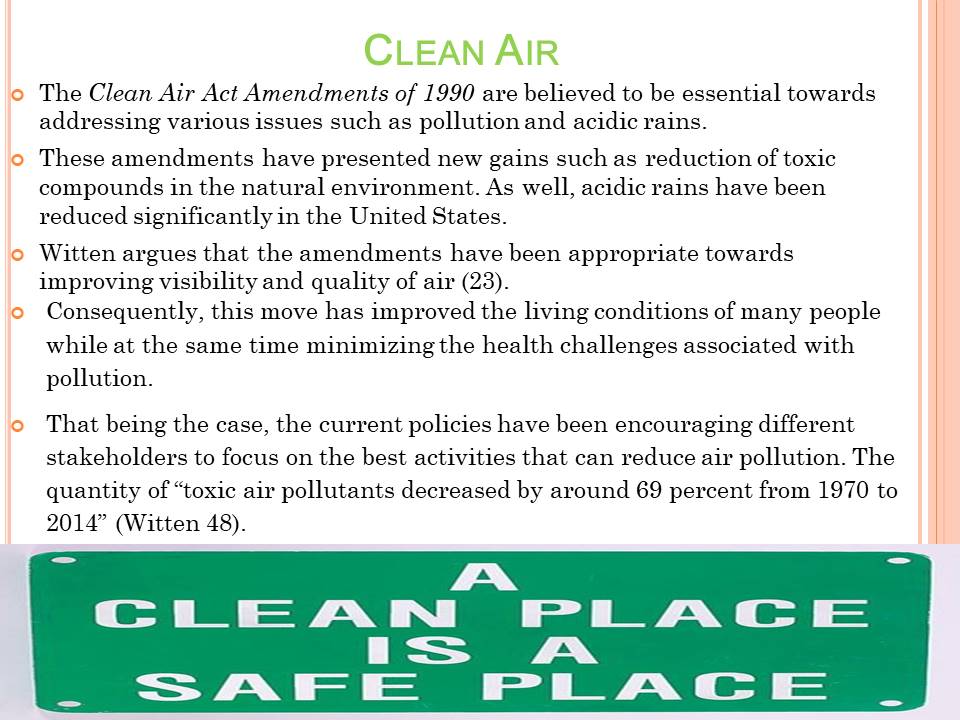
Tobacco Free Air
The health challenges associated with tobacco have forced many regions to promote various strategies that can deliver positive results.
Secondhand tobacco smoke affects the health outcomes of many unsuspecting citizens.
Some states in the United States such as California, Delaware, New Jersey, Wisconsin, New Mexico, Nebraska, Minnesota, Michigan, and Iowa have enacted a number of smoke-free legislations. These laws target public areas, bars, restaurants, workplaces, and institutions (Rojewski 2). As well, more nations have implemented similar laws in order to have tobacco free air.
According to specialists, tobacco smoke contains over seven thousand chemicals including carcinogens (Scheffler et al. 3922). These chemical compounds are usually toxic and have the potential to cause numerous health conditions.
Studies have showed conclusively that secondhand smoke can cause “cancer, cardiovascular disease, and ear infections” (Kalkhoran and Glantz 119).
Medical practitioners have “indicated that there can never be a limit to safe exposure to secondhand smoke” (Scheffler et al. 3923).
Many countries and communities have been focusing on new laws that can result in tobacco-smoke free air. Such laws have been focusing on different regions and public spaces in order to support the health needs of many citizens.

E-Cigarettes and Secondhand Smoke
The electronic cigarette (e-cigarette) has emerged as an innovative alternative to cigarettes (Hyland, Barnoya and Corral 156).
These cigarettes have been observed to increase the level of smoking-cessation in both women and men.
However, the issues of pollution and secondhand smoke have affected the acceptance of e-cigarettes.
For instance, some states such as New York do not allow people to use e-cigarettes in areas and places where smoking is prohibited.
Some of these places include beaches, bars, and offices.
E-cigarettes “contain an e-fluid that is made up of different compounds such as nicotine, flavoring agents, glycerine, and propylene” (Hyland et al. 156).
Many people argue that e-cigarettes do not produce secondhand smoke.
They believe that the e-fluids contained in such cigarettes produce vapor and not smoke.
This issue explains why many people have been divided over the issue of e-cigarettes and secondhand smoke.
However, studies have indicated that such cigarettes are capable of producing tiny particles that pollute the natural environment.
The “tiny participles emitted by such products can also lodge in the user’s lungs and eventually result in various health complications” (Rojewski 2).
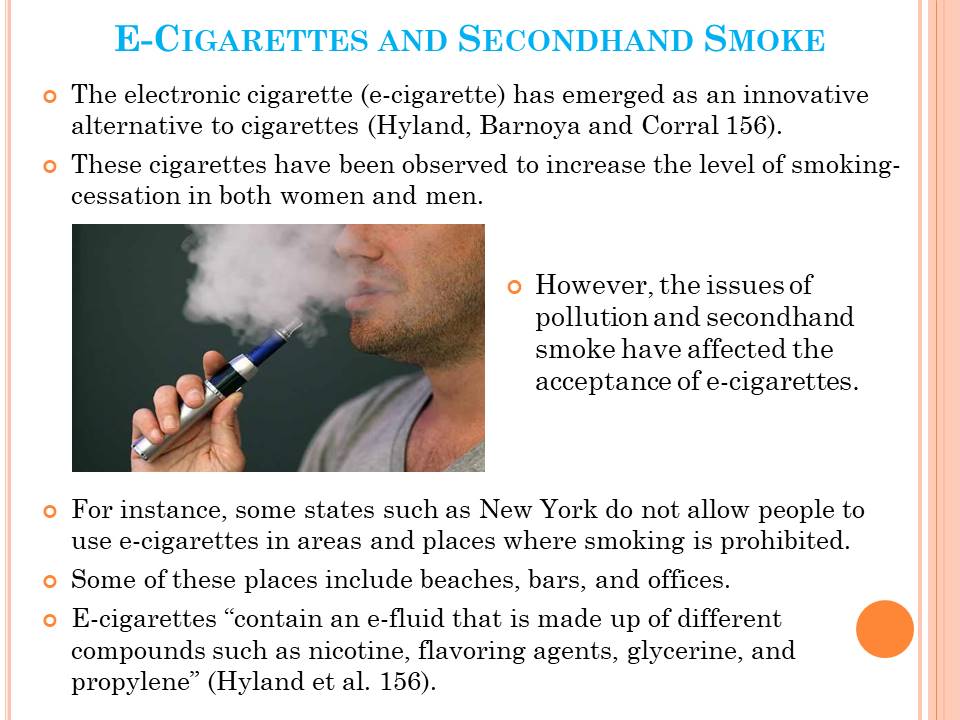

CDC’s Definition
The Centers for Disease Control and Prevention (CDC) uses the name aerosol to define the smoke emitted by e-cigarette users (Hyland et al. 156). This is the case because “vapor is a term used to refer to droplets of water” (Witten 87).
On the other hand, aerosols are tiny compounds and chemicals that might affect the integrity of the environment. Such aerosols can also cause pollution and various diseases.
The aerosols emitted by e-cigarette smokers include silicates and metallic particles. These particles are usually poisonous and toxic to different body organs and cells.
Nicotine is also a major compound contained in such aerosols. These emissions also contain formaldehyde and beta-nicotyrine. These compounds can cause severe health complications. Propylene glycol is also contained in e-cigarette aerosols.
The compound has been observed to cause eye irritation and lung infection. This argument explains why the CDC does not consider such aerosols as water (Rojewski 2).
The CDC therefore identifies such aerosols as harmful chemicals that can affect the health of many people. Such unregulated chemicals and substances affect many e-cigarette users and their relatives.
Different analysts and physicians have been focusing on new ideas that can be used to implement the most desirable regulations. The ultimate goal of such regulations is to protect the health of the greatest number of people.
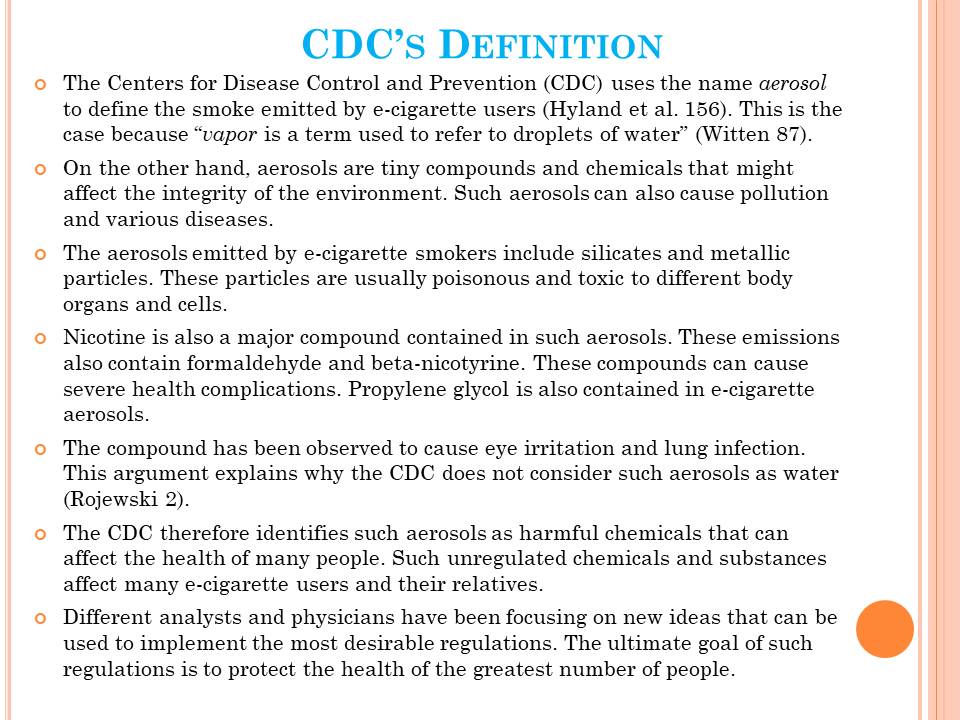
Georgia Quit Line Information
Smoking is a major health concern in many parts of the United States.
The malpractice is also associated with a wide range of problems such as air pollution, diseases, and preventable deaths.
The good news is that more individuals can use various resources and support systems to quit smoking (“Georgia Department of Public Health” par. 1).
The Georgian Tobacco Quit Line (CTQL) is “a public service platform funded by the Tobacco Master Settlement Agreement” (“Georgia Department of Public Health” par. 2).
This effective service has made it easier for many people in the region to quit the malpractice.
The “free and confidential service is usually useful towards helping more Georgians who want to quit smoking” (“Georgia Department of Public Health” par. 2).
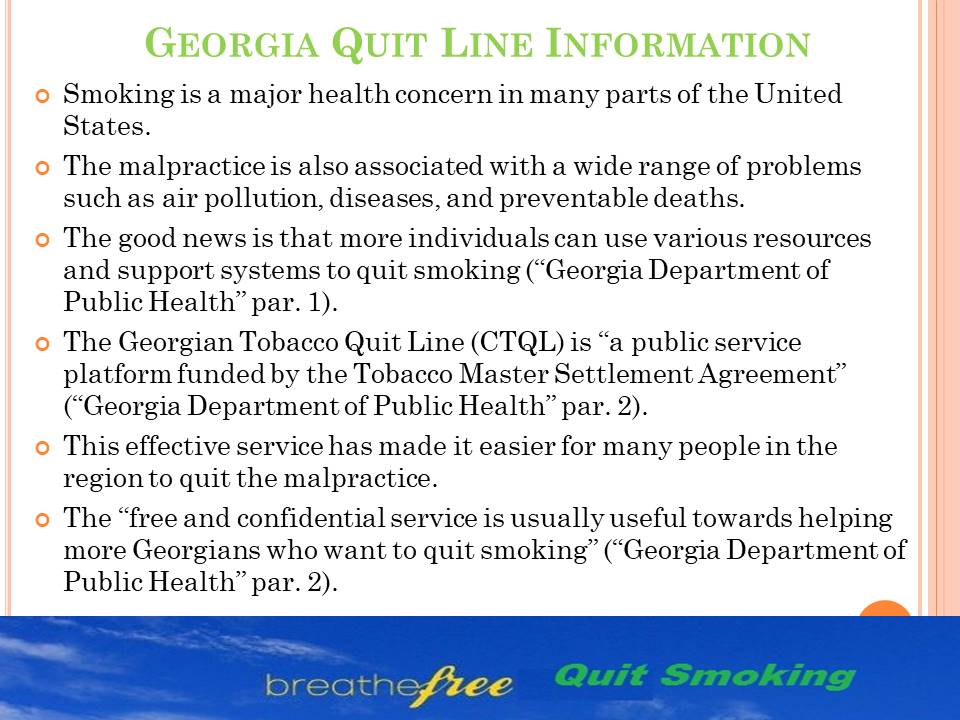
Continuation
In order to deliver positive results, the CTQL is supported by different stakeholders and partners such as the GTUPP.
Web-based support and counseling is also offered to more individuals who want to achieve the best health outcomes.
The counselor focuses on a number of guidelines in order to produce positive results.
These web-based counselors embrace the use of the “United States Public Health Service Treating Tobacco Use and Clinical Practice Guidelines” (“Georgia Department of Public Health” par. 4).
Kalkhoran and Glantz believe strongly that the services provided by the GTQL are evidence-based, timely, and effective (121).
Individuals who want to avoid the health problems associated with tobacco use can therefore benefit from the Georgia Tobacco Quit Line (“Georgia Department of Public Health” par. 5).


Survey Questions
The survey questions presented below can be used by communities and researchers to explore the problem of secondhand smoke in the United States. The findings obtained using such survey questions can be used to implement the best legislations and address the problem of smoking.
- What is secondhand smoke and how does it pose a major health challenge to many people?
- What measures can be undertaken to minimize the number of citizens exposed to secondhand smoke?
- iii. What is the relationship between e-cigarette use and secondhand smoke?
- What laws can be implemented in order to deal with secondhand smoke in the country?
- What should smokers know regarding the dangers of secondhand smoke and e-cigarette-related aerosols?
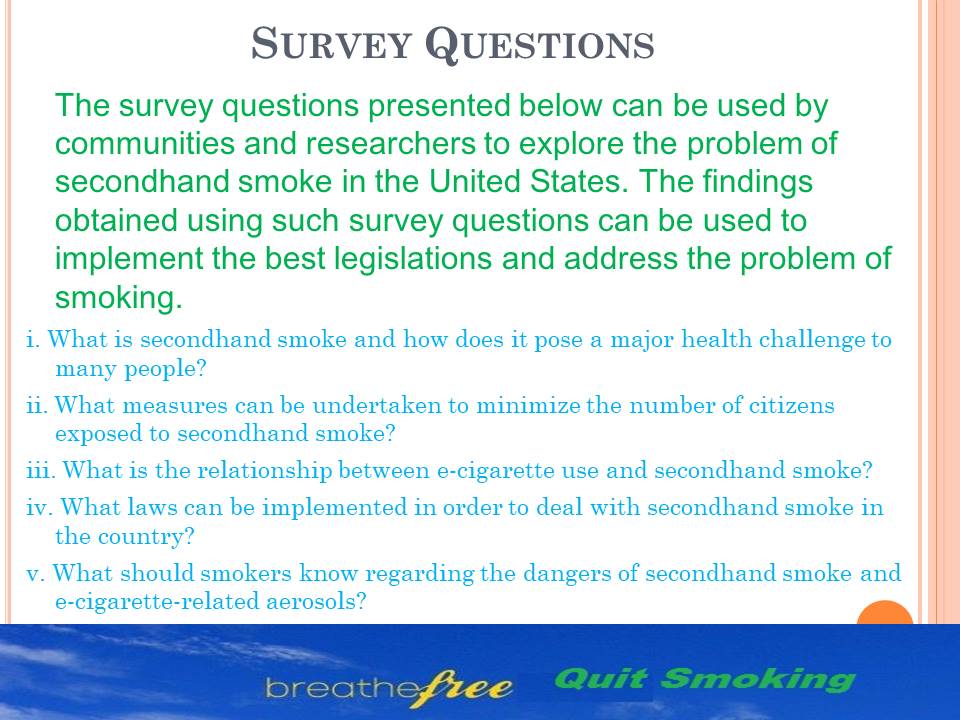
Works Cited
Georgia Department of Public Health 2016.
Hyland, Andrew, Joaquin Barnoya and Juan Corral. “Smoke-Free Air Policies: Past, Present, and Future.” Tobacco Control 21.1 (2012): 154-161. Print.
Kalkhoran, Sara and Stanton Glantz. “E-cigarettes and Smoking Cessation in Real-world and Clinical Settings: A Systematic Review and Meta-Analysis.” The Lancet 4.2 (2016): 116-128. Print.
Rojewski, Alana. “Emerging Policy Issues Regarding Electronic Nicotine Delivery Systems: A Need for Regulation.” Society of Behavioral Medicine 1.1 (2016): 1-3. Print.
Scheffler, Stefanie, Hauke Dieken, Olaf Krischenowski, Christine Forster, Detlev Branschield and Michaela Aufderheide. “Evaluation of E-Cigarette Liquid Vapor and Mainstream Cigarette Smoke after Direct Exposure of Primary Human Bronchial Epithelial Cells.” International Journal of Environmental Research and Public Health 12.1 (2015): 3914-3925. Print.
Witten, Mark. Environmental Tobacco Smoke. Boca Raton, FL: CRC Press, 2003. Print.